This is the sample dataset.
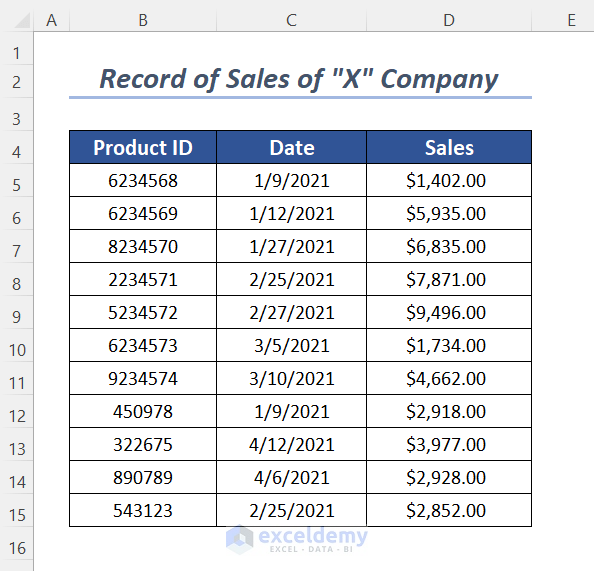
Example 1 – Counting the Number of Different Dates Using the COUNTIF Function with a Multiple Criteria Date Range
To count 1/9/2021 and 2/25/2021 (mm/dd/yyyy format) among the dates in the Date range:
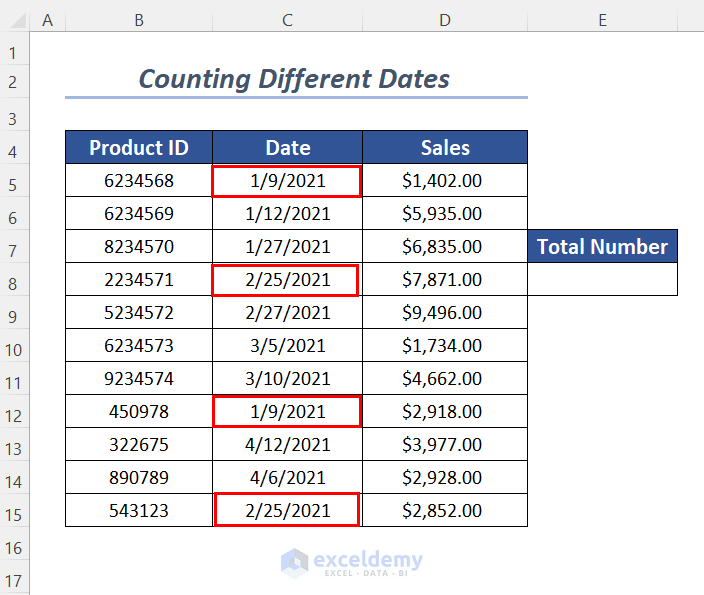
- Enter the following formula in E8.
=COUNTIF(C5:C15,"1/9/2021")+COUNTIF(C5:C15,"2/25/2021")C5:C15 is the date range, and “1/9/2021”, and “2/25/2021” are the criteria.
Formula Breakdown
- COUNTIF(C5:C15,”1/9/2021″) → returns the number of times the date 1/9/2021 is present in the range.
- Output → 2
- COUNTIF(C5:C15,”2/25/2021″) → returns the number of times the date 2/25/2021 is present in the range.
- Output → 2
- COUNTIF(C5:C15,”1/9/2021″)+COUNTIF(C5:C15,”2/25/2021″) → becomes
- 2+2 → 4
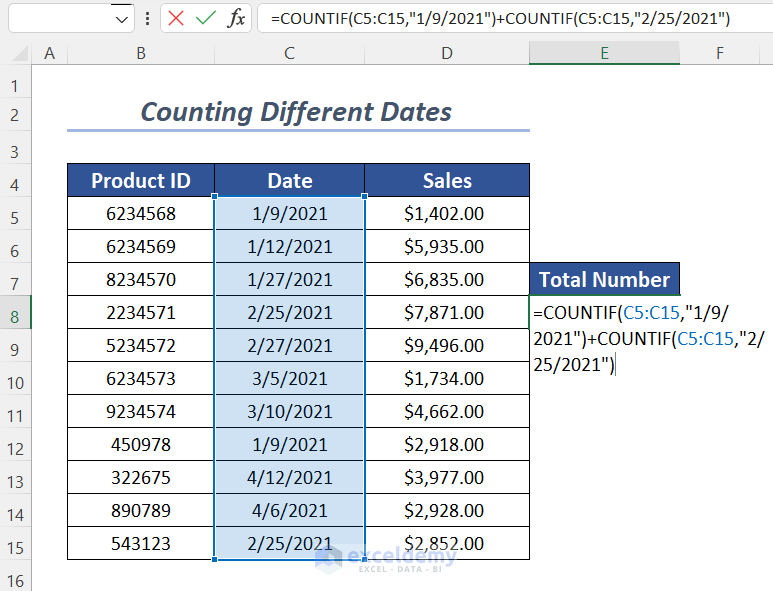
- Press ENTER.
4 is the output.
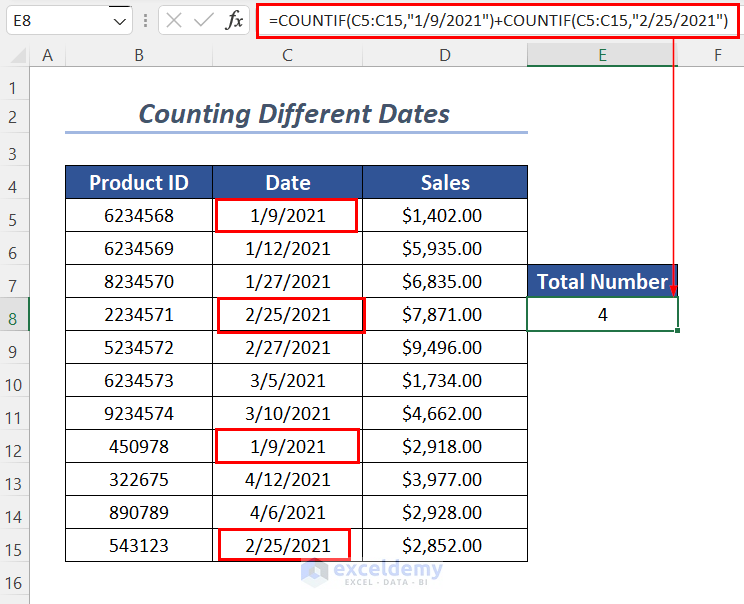
Example 2 – Applying the SUMPRODUCT & COUNTIF Functions to Multiple Criteria in a Date Range
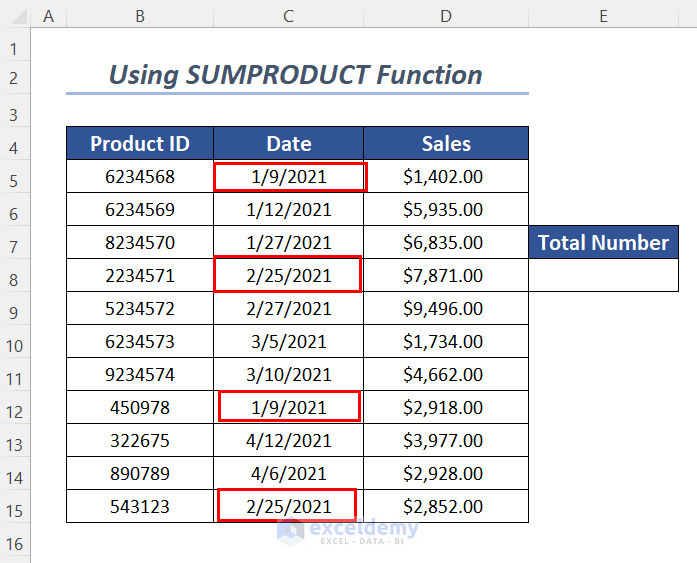
- Use the following formula in E8.
=SUMPRODUCT(COUNTIF(C5:C15,{"1/9/2021","2/25/2021"}))C5:C15 is the date range, and “1/9/2021”, and “2/25/2021” are the criteria.
Formula Breakdown
- COUNTIF(C5:C15,{“1/9/2021″,”2/25/2021”}) → returns an array containing the number “1/9/2021”, and “2/25/2021” appear in the date range.
- Output → {2,2}
- SUMPRODUCT({2,2}) → adds the values inside the array
- Output → 4
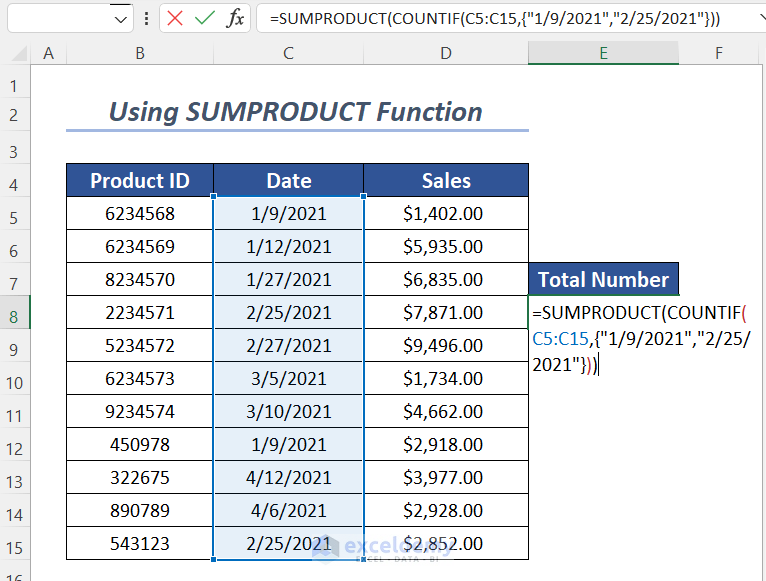
- Press ENTER.
4 is the output.
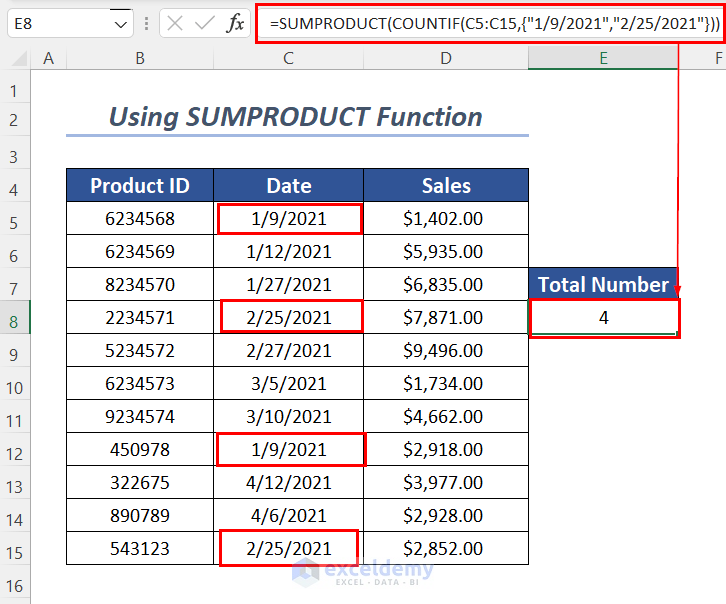
Note: Press CTRL+SHIFT+ENTER instead of ENTER in versions other than Microsoft Excel 365.
Read More: SUMPRODUCT and COUNTIF Functions with Multiple Criteria
Example 3 – Counting Numbers Between Two Dates
To count the number of dates in March in the Date column.
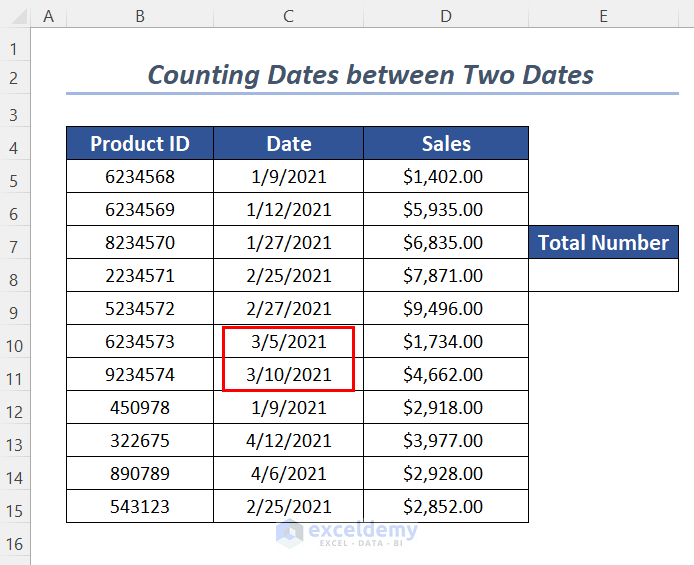
- Use the following formula in E8.
=COUNTIF(C5:C15,">3/1/2021")-COUNTIF(C5:C15,">3/30/2021")C5:C15 is the date range, “>3/1/2021”, and “>3/30/2021” are the criteria.
Formula Breakdown
- COUNTIF(C5:C15,”>3/1/2021″) → counts the number of dates greater than the start date of March
- Output → 4
- COUNTIF(C5:C15,”>3/30/2021″) → counts the number of dates greater than the ending date of March
- Output → 2
- COUNTIF(C5:C15,”>3/1/2021″)-COUNTIF(C5:C15,”>3/30/2021″) → becomes
- 4-2 → 2
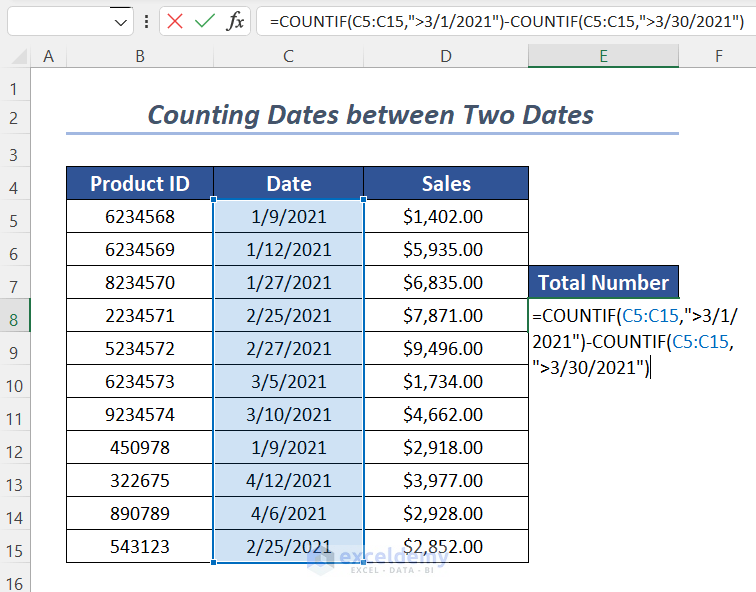
- Press ENTER.
The output is 2.
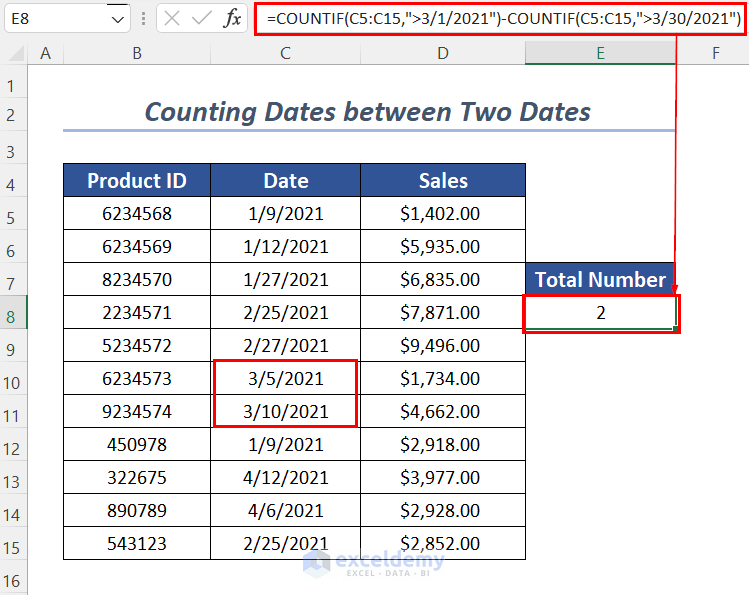
Read More: How to Use COUNTIF Between Two Dates and Matching Criteria in Excel
Example 4 – Using the DATE Function with the COUNTIF Function in Excel
To count the number of dates in March in the Date column:
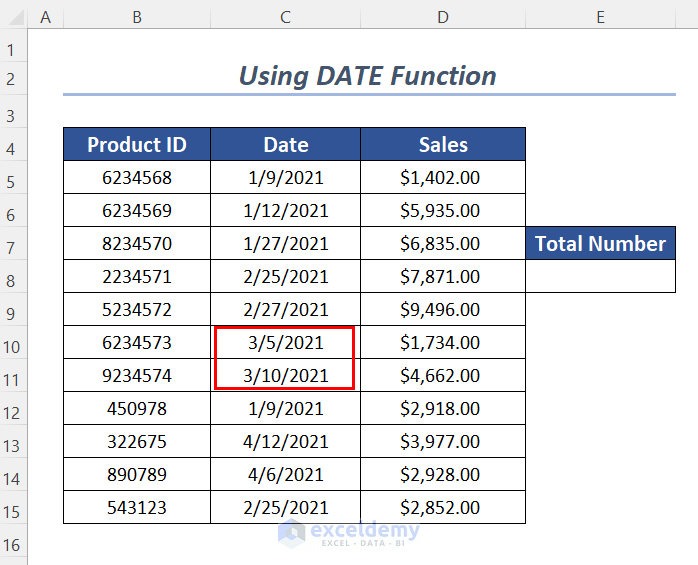
- Enter the following formula in E8.
=COUNTIF(C5:C15,">"&DATE(2021,3,1))-COUNTIF(C5:C15,">"&DATE(2021,3,30))C5:C15 is the date range.
Formula Breakdown
- DATE(2021,3,1) → returns date with the year 2021, month 3, and 1st day of this month.
- Output → 3/1/2021
- COUNTIF(C5:C15,”>”&DATE(2021,3,1)) → becomes
- COUNTIF(C5:C15,”>”&3/1/2021) → The & operator joins the greater than sign with the date.
- COUNTIF(C5:C15,”>3/1/2021″) → counts the number of dates greater than the start date of March
- Output → 4
- DATE(2021,3,30) → returns date with the year 2021, month 3, and 30th day of this month.
- Output → 3/30/2021
- COUNTIF(C5:C15,”>”&DATE(2021,3,30)) → becomes
- COUNTIF(C5:C15,”>”&3/30/2021) → The & operator joins the greater than sign with the date.
- COUNTIF(C5:C15,”>3/30/2021″) → counts the number of dates greater than the start date of March
- Output → 2
- COUNTIF(C5:C15,”>”&DATE(2021,3,1))-COUNTIF(C5:C15,”>”&DATE(2021,3,30)) → becomes
- 4-2 → 2
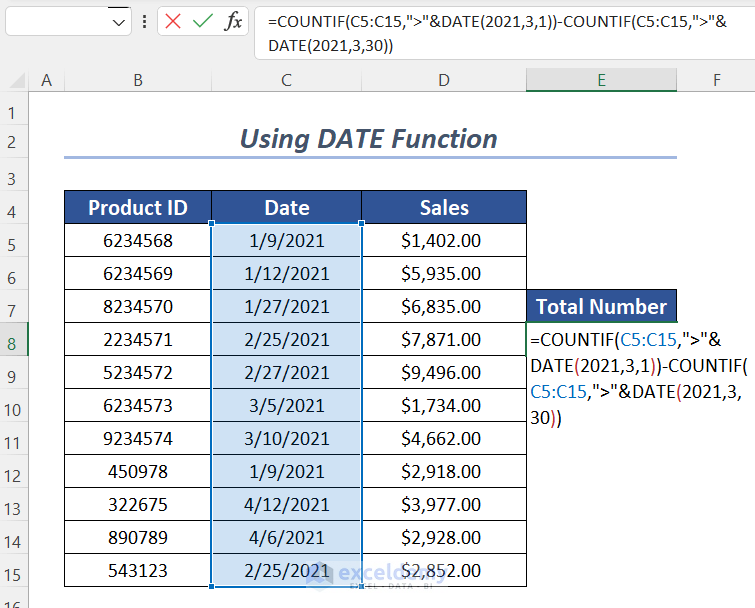
- Press ENTER.
The output is 2.
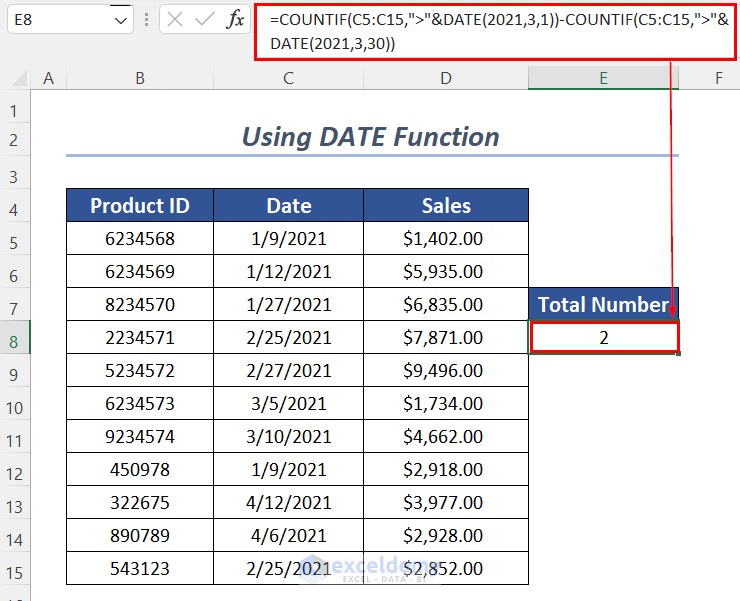
Similar Readings
- How to Use COUNTIF with Multiple Criteria in the Same Column in Excel
- COUNTIF with Multiple Criteria in Different Columns in Excel
Example 5 – Applying the EOMONTH and the COUNTIF Functions with Multiple Criteria in a Date Range
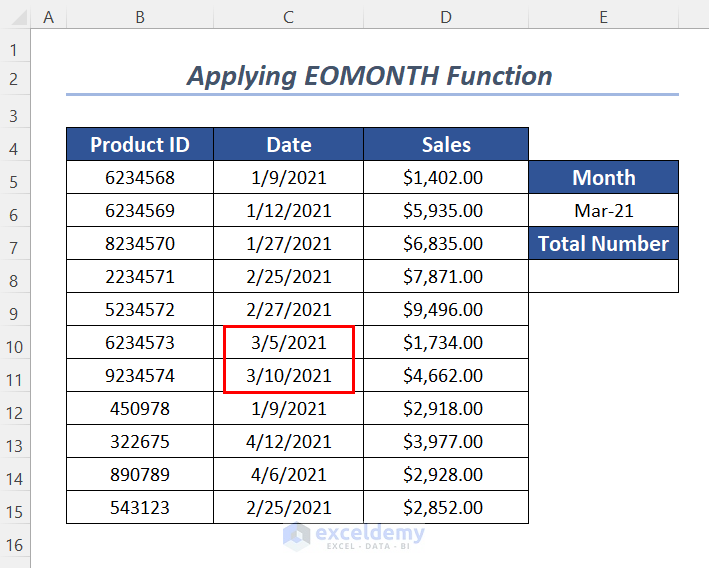
- Use the following formula in E8.
=COUNTIF(C5:C15,">"&E6)-COUNTIF(C5:C15,">"&EOMONTH(E6,0))C5:C15 is the date range, and E6 is the starting date of March.
Formula Breakdown
- COUNTIF(C5:C15,”>”&E6) → becomes
- COUNTIF(C5:C15,”>”&3/1/2021) → The & operator joins the greater than sign with the date.
- COUNTIF(C5:C15,”>3/1/2021″) → counts the number of dates greater than the start date of March
- Output → 4
- EOMONTH(E6,0) returns the end date of March
- Output → 3/31/2021
- COUNTIF(C5:C15,”>”&EOMONTH(E6,0)) → becomes
- COUNTIF(C5:C15,”>”&3/31/2021) → The & operator joins the greater than sign with the date.
- COUNTIF(C5:C15,”>3/31/2021″) → counts the number of dates greater than the start date of March
- Output → 2
- COUNTIF(C5:C15,”>”&DATE(2021,3,1))-COUNTIF(C5:C15,”>”&DATE(2021,3,31)) → becomes
- 4-2 → 2
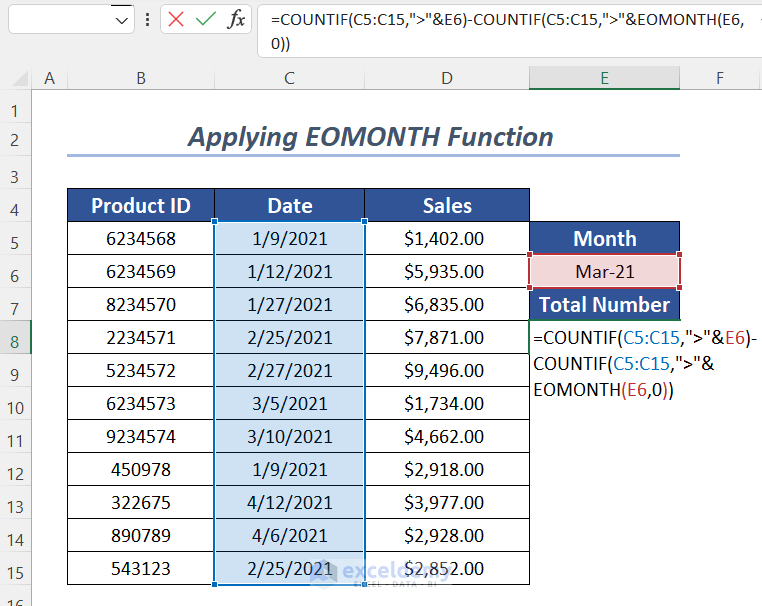
- Press ENTER to see the output.
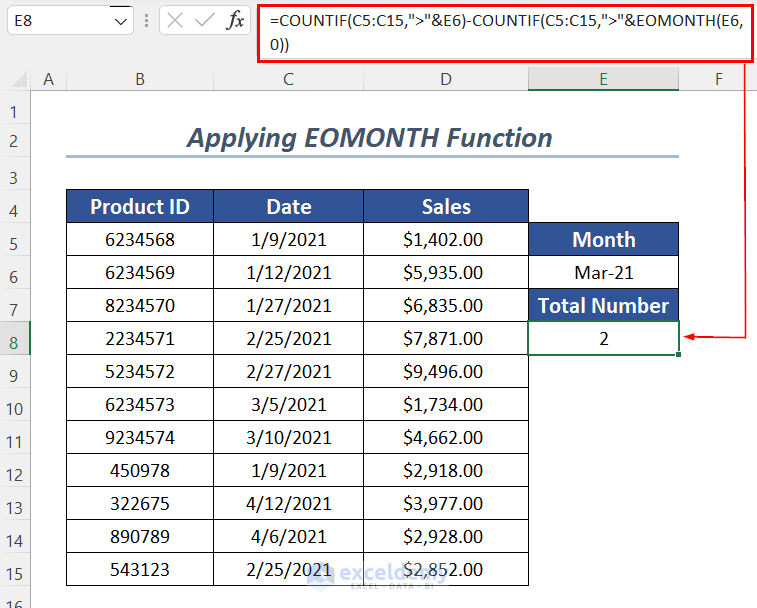
Example 6 – Using the COUNT, IF, MONTH, and YEAR Functions
To count the number of dates in January with sales values greater than 5000 USD:
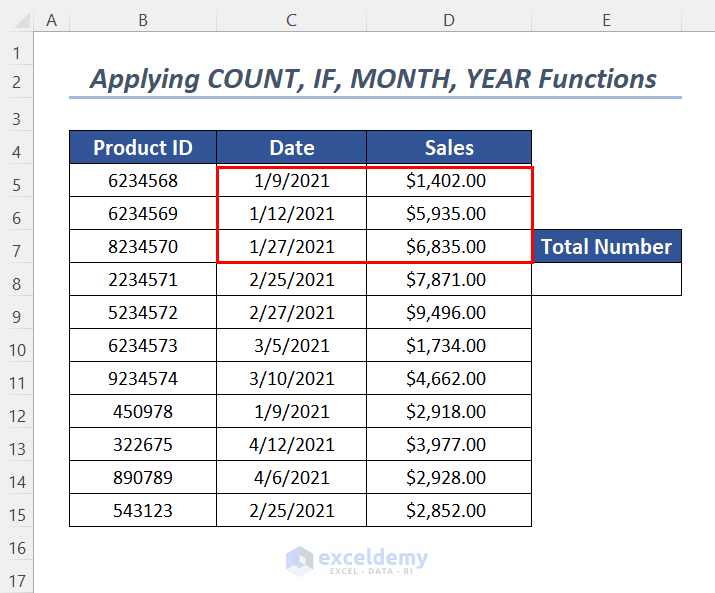
- Use the following formula in E8.
=COUNT(IF(MONTH(C5:C15)=1,IF(YEAR(C5:C15)=2021,IF(D5:D15>5000,D5:D15))))C5:C15 is the date range.
Formula Breakdown
- MONTH(C5:C15)=1 → MONTH returns the month values of the dates
- {1;1;1;2;2;3;3;1;4;4;2} = 1 → returns TRUE for 1 in the array
- Output → {TRUE;TRUE;TRUE;FALSE;FALSE;FALSE;FALSE;TRUE;FALSE;FALSE;FALSE}
- {1;1;1;2;2;3;3;1;4;4;2} = 1 → returns TRUE for 1 in the array
- YEAR(C5:C15)=2021 → YEAR returns the year values of the dates
- {2021;2021;2021;2021;2021;2021;2021;2021;2021;2021;2021} = 2021 → returns TRUE for 2021 in the array
- Output → {TRUE;TRUE;TRUE;TRUE;TRUE;TRUE;TRUE;TRUE;TRUE;TRUE;TRUE}
- {2021;2021;2021;2021;2021;2021;2021;2021;2021;2021;2021} = 2021 → returns TRUE for 2021 in the array
- D5:D15>5000 → returns TRUE when the sales values are greater than 5000
- Output → {FALSE;TRUE;TRUE;TRUE;TRUE;FALSE;FALSE;FALSE;FALSE;FALSE;FALSE}
- IF(D5:D15>5000,D5:D15) → becomes
- IF({FALSE;TRUE;TRUE;TRUE;TRUE;FALSE;FALSE;FALSE;FALSE;FALSE;FALSE},D5:D15)
- Output → {FALSE;5935;6835;7871;9496;FALSE;FALSE;FALSE;FALSE;FALSE;FALSE}
- IF({FALSE;TRUE;TRUE;TRUE;TRUE;FALSE;FALSE;FALSE;FALSE;FALSE;FALSE},D5:D15)
- IF(YEAR(C5:C15)=2021,IF(D5:D15>5000,D5:D15)) → becomes
- IF({TRUE;TRUE;TRUE;TRUE;TRUE;TRUE;TRUE;TRUE;TRUE;TRUE;TRUE},{FALSE;5935;6835;7871;9496;FALSE;FALSE;FALSE;FALSE;FALSE;FALSE})
- Output → {FALSE;5935;6835;7871;9496;FALSE;FALSE;FALSE;FALSE;FALSE;FALSE}
- IF({TRUE;TRUE;TRUE;TRUE;TRUE;TRUE;TRUE;TRUE;TRUE;TRUE;TRUE},{FALSE;5935;6835;7871;9496;FALSE;FALSE;FALSE;FALSE;FALSE;FALSE})
- IF(MONTH(C5:C15)=1,IF(YEAR(C5:C15)=2021,IF(D5:D15>5000,D5:D15))) → becomes
- IF({TRUE;TRUE;TRUE;FALSE;FALSE;FALSE;FALSE;TRUE;FALSE;FALSE;FALSE},{FALSE;5935;6835;7871;9496;FALSE;FALSE;FALSE;FALSE;FALSE;FALSE})
- Output → {FALSE;5935;6835;FALSE;FALSE;FALSE;FALSE;FALSE;FALSE;FALSE;FALSE}
- IF({TRUE;TRUE;TRUE;FALSE;FALSE;FALSE;FALSE;TRUE;FALSE;FALSE;FALSE},{FALSE;5935;6835;7871;9496;FALSE;FALSE;FALSE;FALSE;FALSE;FALSE})
- COUNT(IF(MONTH(C5:C15)=1,IF(YEAR(C5:C15)=2021,IF(D5:D15>5000,D5:D15)))) → becomes
- COUNT({FALSE;5935;6835;FALSE;FALSE;FALSE;FALSE;FALSE;FALSE;FALSE;FALSE}) → counts the number values in the range
- Output → 2
- COUNT({FALSE;5935;6835;FALSE;FALSE;FALSE;FALSE;FALSE;FALSE;FALSE;FALSE}) → counts the number values in the range
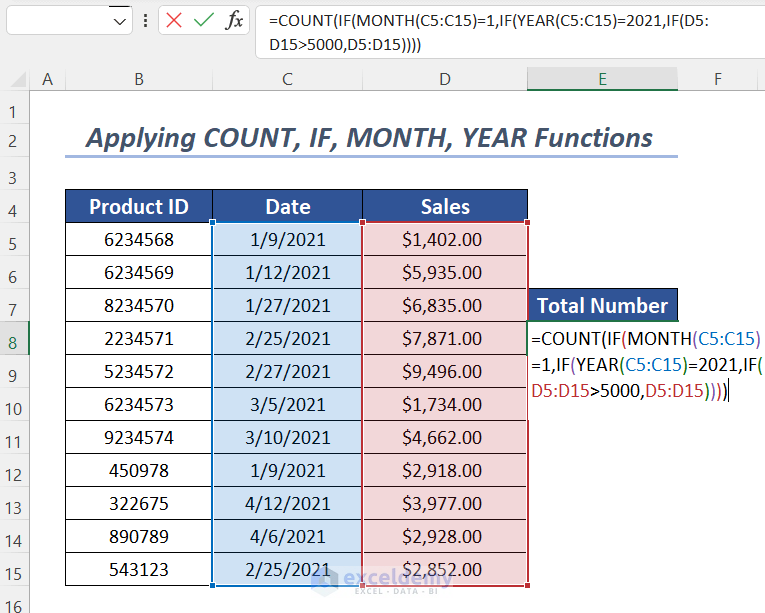
- Press ENTER.
This is the output.
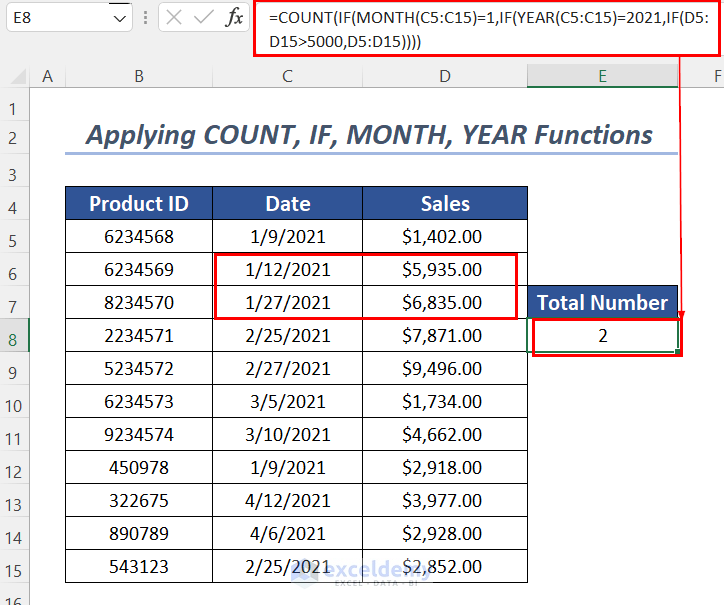
Applying the COUNTIFS Function for Multiple Criteria in a Date Range in Excel
To count the number of dates in January with sales values greater than 5000 USD.
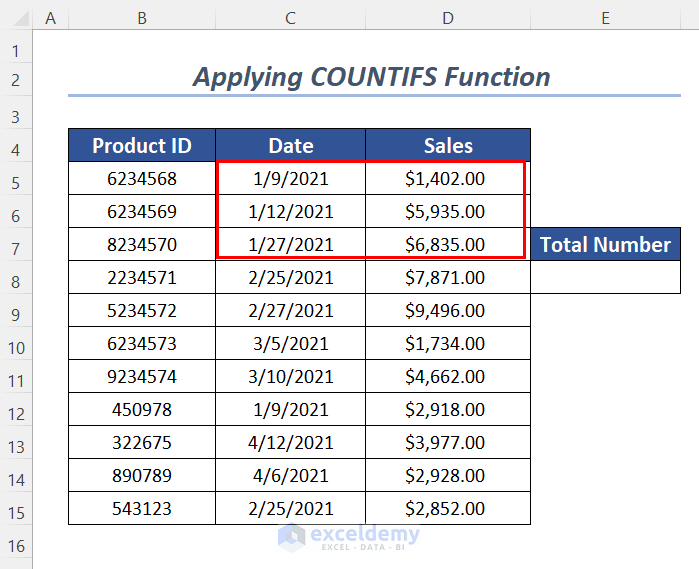
- Enter the following formula in E8.
=COUNTIFS(C5:C15,">1/1/2021",C5:C15,"<1/31/2021",D5:D15,">"&5000)C5:C15, and D5:D15 are the criteria ranges, “>1/1/2021”, “<1/31/2021”, and “>”&5000 are the criteria.
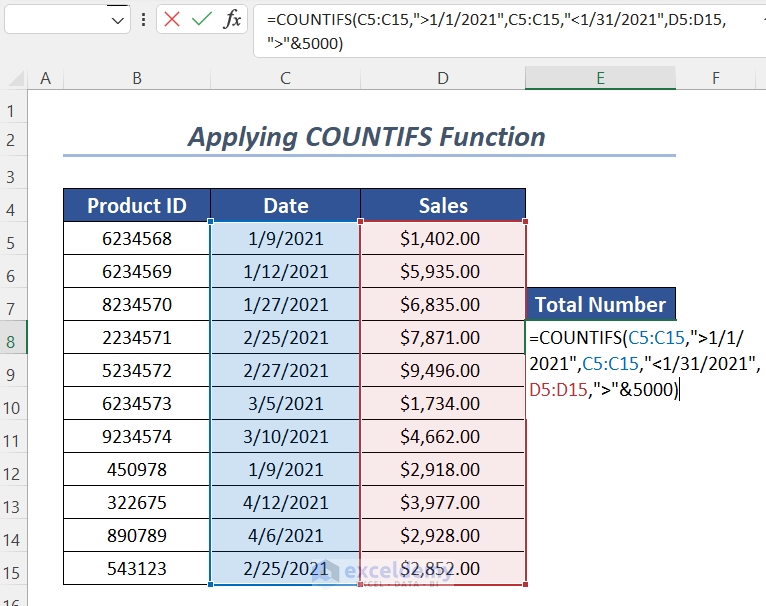
- Press ENTER.
This is the output.
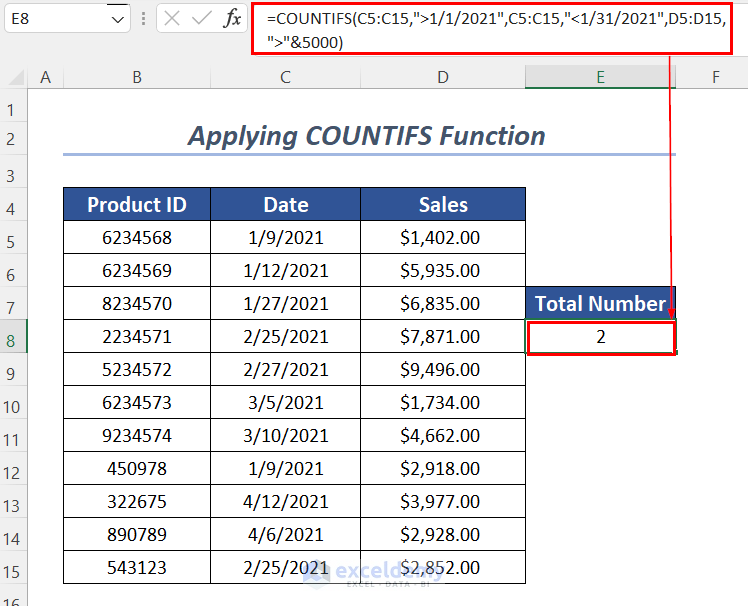
Practice Section
Practice here.
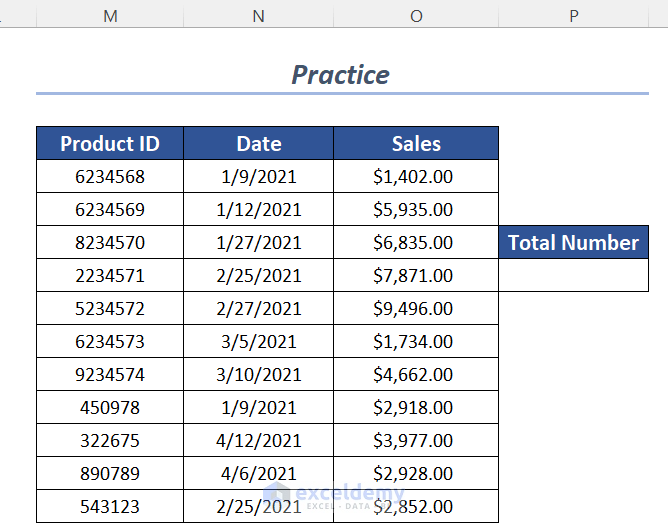
Download Workbook
Related Articles
- COUNTIF Between Two Values with Multiple Criteria in Excel
- How to Use COUNTIF for Cells Not Equal to Text or Blank in Excel
- How to Use COUNTIF Function Across Multiple Sheets in Excel
- How to Apply SUM and COUNTIF for Multiple Criteria in Excel
<< Go Back to COUNTIF Multiple Criteria | Excel COUNTIF Function | Excel Functions | Learn Excel
Get FREE Advanced Excel Exercises with Solutions!

